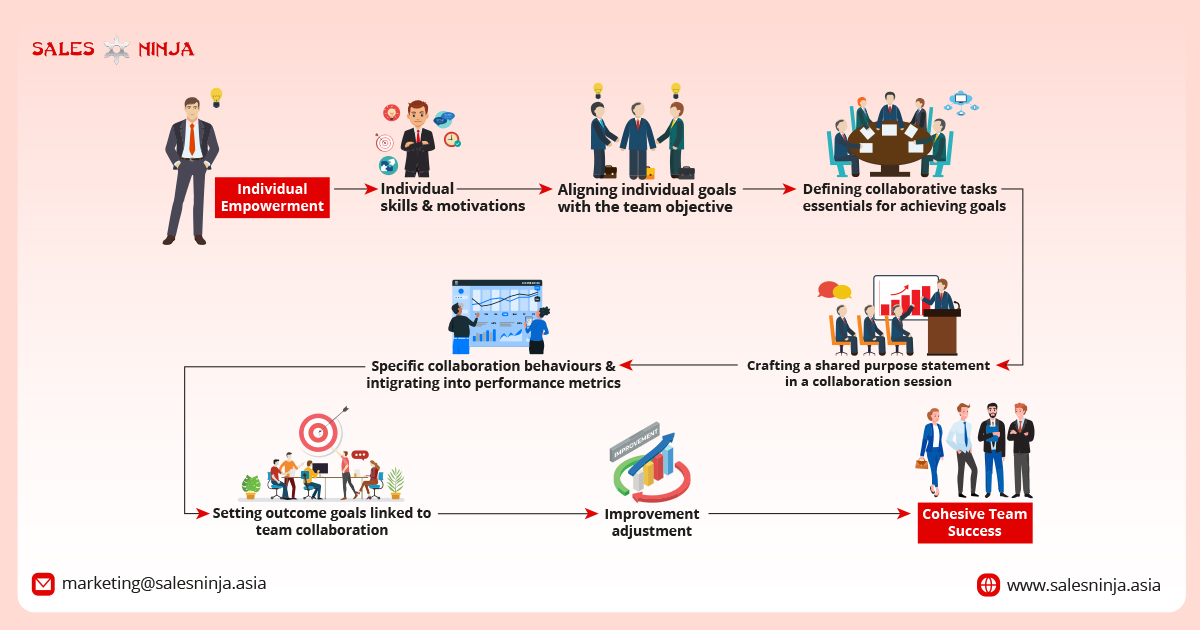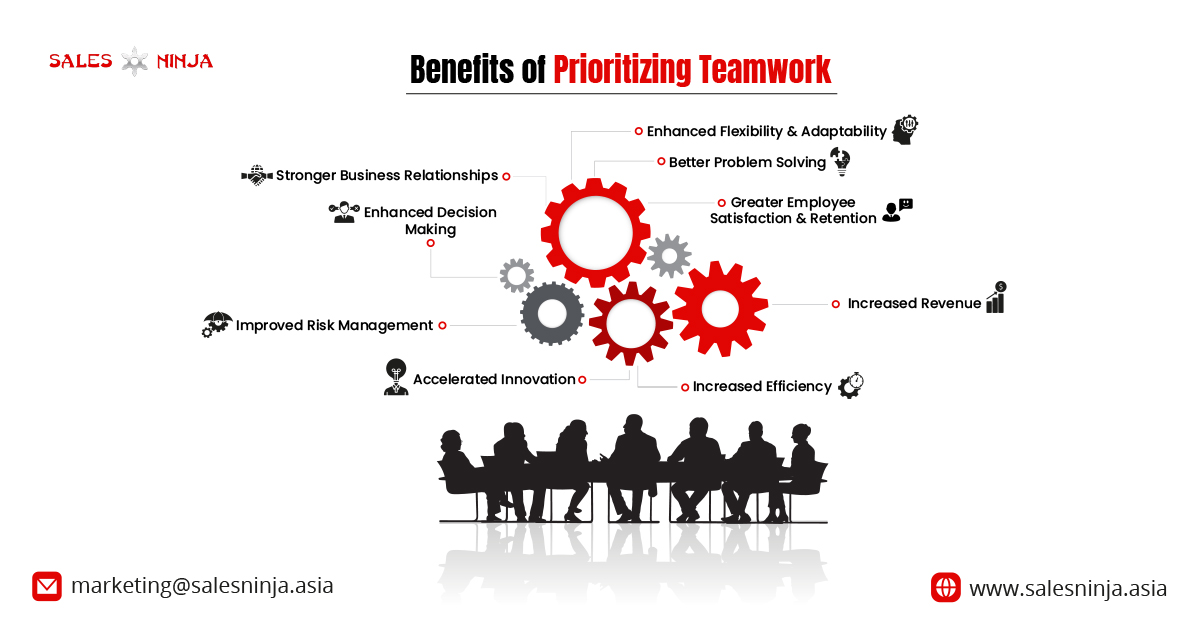The concept of teamwork is as ancient as humanity itself, but never has it been more critical to business growth than in our interconnected world today. The days of siloed work are fading, giving way to a new era where collaboration isn’t just encouraged—it’s essential.
Why prioritize teamwork?
“Probably the most important thing I’ve learned up here is the importance of teamwork.” —NASA Astronaut Douglas Wheelock
Because, when a group of diverse individuals brings their unique perspectives to a shared table, the result is a symphony of ideas that can overcome the most complex challenges. It’s a dance of different talents, all stepping to the rhythm of a common goal. This is the crucible where the ordinary becomes extraordinary, where the sum is indeed greater than its parts.
How team structure has established a foundation for firms’ successes from prior generations
Teamwork is not a new concept in modern corporate strategists; it’s as old as commerce itself. If we turn the pages of history, we find that the most successful businesses have always been built on the bedrock of solid teamwork. From the guilds of medieval Europe to the industrial powerhouses of the 20th century, the collective effort has been the fuel that powers the engine of progress.
In medieval Europe, the guilds were more than just associations; they were the original “teams” of craftsmen and merchants who pooled their knowledge and skills. The guilds operated on the principles of mutual support and shared knowledge, with master craftsmen passing on their skills to apprentices. This team structure ensured quality control and fostered innovation within the trades. The guilds are prime historical examples of how teamwork can lead to sustained business success over generations.
Fast forward to the Industrial Revolution, the assembly line introduced by Henry Ford was a revolutionary team structure that changed the face of manufacturing. Ford’s model relied on a trust-based system where each worker’s contribution was integral to the overall product. This not only maximized efficiency but also set a new standard for how teams could work together to achieve extraordinary results.
A Legacy of Teamwork
Today, as we stand on the shoulders of these historical giants, we see a clear pattern. Successful firms have consistently leveraged team structures for their achievements. As we embrace these enduring principles, we can continue to build firms that not only survive the test of time but also thrive in the face of future challenges.
The current need for teamwork and collaboration within corporations
“Individuals who work in collaborative settings are more than 50% more effective at completing tasks than those who work independently “
There is currently a growing need for teamwork and collaboration within corporations. This is due to a number of factors, including the following:
- Business complexity and diversity now require cross-departmental teamwork to meet shared objectives.
For instance, when a company launches a new product, it’s not just the job of the design team to create it or the manufacturing team to build it. The marketing team must understand the product to promote it effectively, the sales team needs to know how to sell it, and the customer service team should be prepared to answer queries and solve issues related to it.
This requires all these different areas to communicate, share knowledge, and align their strategies to ensure the product succeeds in the market.
Tip: Implement project management tools that allow visibility and communication across departments.
- Globalization has intensified competition, necessitating businesses to unite their strengths to thrive in today’s market.
As businesses cross borders, they face new challenges and competitors. To stand out, they need to bring together the best ideas and skills from their entire organization. This means people from different countries, with different experiences and perspectives, must work together as one team.
By pooling their collective strengths—like unique local insights from international team members, varied professional expertise, and a range of creative approaches—companies can navigate the complexities of a global market more effectively. They can make better products, offer more relevant services, and understand diverse customer needs better.

For instance, a tech company in the United States might collaborate with its design team in Italy, its manufacturing unit in China, and its customer service team in India. By working together, they can ensure that the product is not only well-designed and efficiently produced but also meets the specific requirements of different customer bases worldwide.
Firms that encourage their teams to work closely, share knowledge, and innovate collectively are more likely to succeed in the global marketplace.
Tip: Encourage cultural exchange programs within the company to foster mutual understanding and respect.
- Digital advances and new tech have boosted data sharing across departments, demanding better teamwork.
Before digitalization, departments often worked in isolation, with little interaction or sharing of information. However, modern technologies have broken down these silos, making it possible for departments to access and share data in real-time. This shift has profound implications for collaboration.
For instance, customer data collected by sales teams can now be instantly available to the marketing department, allowing them to tailor campaigns more effectively. Similarly, insights gained by data analysis teams can inform product development processes, leading to more informed decision-making and innovation.

This interconnectedness means that departments can no longer function effectively in isolation. The increased flow of data has created a need for more strategic and productive collaboration. Teams must now come together to analyze, interpret, and act upon the wealth of information that digital tools provide.
- Increased customer demands require collaborative cultures.
These days, customers want things faster, better, and tailored just for them. They’re not just buying a product or service; they’re buying an experience. And they want that experience to be top-notch every single time.
In order to meet these demands, companies must operate as a cohesive team rather than relying solely on individual efforts or separate departments. The speed at which a company can respond to customer needs can often be the differentiator between success and obsolescence.

Tip 1: Foster a customer-centric approach where feedback is regularly sought and shared among teams.
Tip 2: Encourage teams to engage in joint problem-solving sessions to address customer issues promptly and innovatively.
Strong teams start with individual
“The strength of the team is each individual member. The strength of each member is the team.” – Phil Jackson
For effective team building and teamwork, the key is to start by clarifying each team member’s individual motivations and how these align with the team’s collective goals. This involves understanding why collaboration is necessary to achieve business outcomes and identifying specific tasks that require a cooperative approach. Ensuring that team members see the direct link between their collaborative efforts and the team’s success is crucial.
It’s about creating a sense of shared purpose and accountability, where collaborative work is not just an abstract concept but a concrete element of each person’s role. The focus should be on tangible results from joint efforts rather than on building relationships through traditional team-building activities, which may not translate into improved teamwork in the workplace.
By engaging each team member in defining and committing to collaborative behaviors and incorporating these into performance objectives, teamwork becomes a driver of results, with trust and strong relationships developing as a byproduct of successful collaboration.

To put it simply, if you want a strong team, start by empowering the individual. Equip each member with clarity about their role, show them how their contributions matter, and watch as these collective efforts culminate in a team that’s not just effective, but exceptional.
Benefits associated with prioritizing teamwork
When discussing the benefits of prioritizing teamwork, it’s essential to consider the tangible outcomes that collective effort can yield. From enhanced decision-making to fostering innovation, teamwork has a measurable impact on a company’s growth trajectory.
- Enhanced Decision-Making
Collaborative decision-making allows for a diversity of thoughts and perspectives to come together, which often leads to more informed and robust outcomes. When a team works together to analyze data, brainstorm solutions, and assess risks, the decisions made are generally of higher quality. According to a study, teams that prioritize inclusive decision-making processes see a 60% improvement in decision-making abilities. This collective intelligence positions the company to capitalize on opportunities faster, directly influencing growth and market share.
- Accelerated Innovation
“If everyone in the team is making decisions and taking actions together, then you have the right culture for innovation.” — Sandeep Kashyap
Innovative products and services are often the differentiators in a crowded market. It thrives on the exchange of ideas, challenging assumptions, and building upon the collective knowledge of a group. According to a report, collaborative decision-making can lead to a 50% increase in innovation and companies fostering collaborative innovation enjoy a 30% higher rate of new product development success. Teamwork can transform a single spark of creativity into a full-blown fire of innovation. This can result in capturing new markets or expanding the company’s offerings, thereby increasing revenue.
- Increased Efficiency
When a team works well together, processes become more streamlined. The team can identify the most effective ways to accomplish tasks, often resulting in time and cost savings. Streamlined processes and time savings translate into reduced operational costs, allowing the company to allocate resources more effectively. Companies with collaborative teams can see a 35% increase in productivity. Efficiency gains can also lead to faster time-to-market for products and services, giving the company a competitive edge and improving customer satisfaction, which is crucial for growth.
- Greater Employee Satisfaction and Retention
Teams that work well together report higher levels of job satisfaction (almost 12%). This is not only beneficial for the employees’ well-being but also for the company’s bottom line. You won’t believe that businesses with high employee engagement report a 24% higher retention rate. These high employee retention rates lower recruitment and training costs and maintain institutional knowledge within the company. Furthermore, satisfied employees are often the company’s best ambassadors, attracting top talent and thus ensuring the company has the human capital necessary for expansion and innovation.
- Better Problem-Solving
Teamwork allows for pooling diverse skill sets to tackle challenges effectively. When individuals with different backgrounds and expertise collaborate, they can approach problems from various angles, leading to more innovative solutions. This ability to tackle problems head-on without being derailed ensures the company remains resilient and on a growth trajectory, even in turbulent times.

- Enhanced Flexibility and Adaptability
In a rapidly changing business environment, adaptability is key. Teams that are used to working together can pivot more easily in response to market shifts or internal changes, allowing the company to stay relevant and competitive. This flexibility can open new revenue streams and prevent losses associated with outdated practices or products.
- Stronger Business Relationships
Collaborative teams often extend their cooperative spirit beyond the company walls, engaging more effectively with clients, suppliers, and partners. This can lead to more successful negotiations, long-term partnerships, and an overall better reputation in the industry. A study by the Institute for Corporate Productivity (i4cp) found that organizations with strong external networks have a 48% higher market share and profitability.
- Improved Risk Management
Group discussions often bring potential risks to light earlier and allow for more effective risk management strategies. Teams that prioritize collaboration are better at identifying potential pitfalls and developing contingency plans.
“Companies with collaborative project teams reduce their risk of project failure by up to 30%.“
Early risk identification and management protect the company from potential losses and ensure that projects and ventures are more likely to succeed. By safeguarding its assets and ensuring successful project completion, the company can invest confidently in growth opportunities.
- Increased Revenue
Ultimately, all the above factors contribute to the bottom line. Effective teamwork leads to improved performance across the board, which can significantly impact revenue. Data from Salesforce indicates that companies prioritizing teamwork see up to a 26% increase in revenue. This increased revenue can then be reinvested in further growth initiatives, creating a virtuous cycle of expansion and improvement.
In essence, the benefits of teamwork are not just theoretical; they are real, measurable, and impactful. Integrating teamwork into the fabric of company operations can transform individual potential into collective success, driving innovation, and securing a competitive edge in the market.
“Collaboration and teamwork improve company sales by 27%, product quality by 34%, and product development by 30%.”
Bottom Line
Wrapping up, the real secret to a successful business is getting everyone to work together. It’s about mixing everyone’s different ideas and skills to make something even better than what one person could do alone. Companies should make sure they’re getting everyone to chip in, not just pushing people to do their own thing.
When everyone in the team knows they’re important and that their ideas matter, they’re going to work harder and come up with cooler stuff. This is how a business gets ahead.




